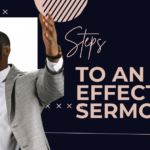As an Amazon Associate I earn from qualifying purchases.
 I was talking to a laymember the other day who was very excited about a sermon he had heard. The member gave me all four of the points of the sermon and was excited about applying the sermon to his daily life. Interestingly enough, he searched on the internet to try to find this sermon and other sermons by the same preacher.
I was talking to a laymember the other day who was very excited about a sermon he had heard. The member gave me all four of the points of the sermon and was excited about applying the sermon to his daily life. Interestingly enough, he searched on the internet to try to find this sermon and other sermons by the same preacher.
The preacher was a white American preacher. This preacher didn’t yell. His voice did keep a pleasant rising and lowering due to a natural conversational tone. The preacher didn’t whoop or use any other “stylistic” components of the African American Preaching Tradition. So What did the preacher do?
Clear Points
The preacher did three things that I have written on in other posts that can help any preacher’s sermons. The first thing he did was had clear and easily identifiable points. The people did not have to guess about what was important, the preacher simply told them. The preacher clearly defined the points and clearly defined what he meant by the points. We as preachers cannot expect anyone to remember our points if they don’t even know what they are.
Illustrate Point Well
The second thing the preacher did was clearly illustrated the points with stories. Each and every main point had a story connected to it. These stories were memorable and clearly connected to the point. Sometimes we tell stories that are only tangentially related to the point. Stop doing that. It takes away from your message. However, if you have a clear point and a relevant memorable story, you are well on the way to a sermon that people will remember.
Each Point Stronger than Previous One
Finally, the preacher’s stories were more intense as the sermon continued. The layperson told me that each story and point was “stronger” than the other one. Please note that I am not talking about yelling to manufacture intensity, I am talking about the content being stronger. So point two was stronger than point one, and point three was stronger than point two, and point four was stronger than point three. Here was a use of the “whooping curve” without necessarily whooping. We must leave people with the strongest content at the end, and that content should be related to the point illustrated and the main point of the sermon.
Here was an effective preacher who had content that the people remembered. And the people were ready to apply it to their daily lives. If we are to learn from this preacher, we must clearly define our points, illustrate them well with stories, and make each point progressively intense. Then the people will understand and be ready to apply the sermon.
Amazon and the Amazon logo are trademarks of Amazon.com, Inc, or its affiliates.







The white American preacher’s way is another example of how to prepare a sermon and the way to deliver it. As I told in my previous posts, we should also be creative in our message to add spice and variety without putting the Word as a mere “cake topping” but as the main ingredient.
I had not taken the time to read and listen to some of the articles in a while, but I was delighted with finding answers to some questions I had been thinking about that I needed to explore. Thanks again